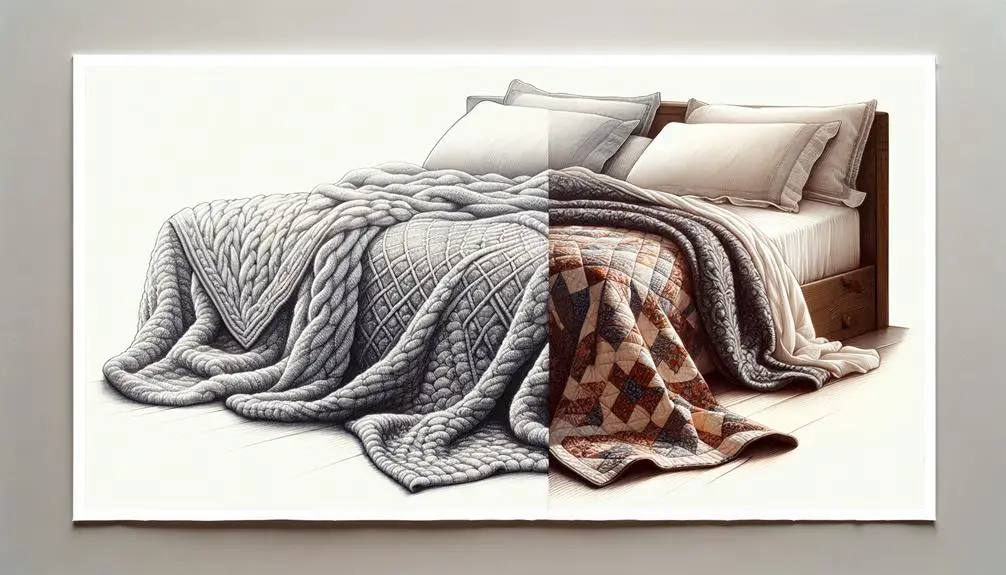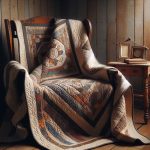So, did you know that according to a recent survey, 60% of people struggle to differentiate between a bedspread and a quilt?
Well, the distinction is more than just semantics. While both serve similar purposes, there are key differences in their design, materials, and functionality.
Understanding these disparities can help you make an informed decision about which option best suits your needs and style preferences.
Let's unravel the mystery behind what sets a bedspread apart from a quilt and how to choose the right one for your bedroom.
Table of Contents
Key Takeaways
- Bedspreads are single-layer woven covers, while quilts have three layers with intricate stitching designs.
- Quilts offer extra warmth and versatility with unique decorative motifs compared to bedspreads.
- Bedspreads prioritize elegance and heavier warmth, while quilts are lighter and suitable for all seasons.
- Quilts feature detailed stitching patterns for even warmth distribution, while bedspreads offer simplicity and elegance in design.
Definition of Bedspread and Quilt
When distinguishing between a bedspread and a quilt, it's important to understand their fundamental definitions and unique characteristics. Bedspreads are woven bed covers that typically extend to the floor, offering a traditional and elegant look while providing ample coverage. On the other hand, quilts are thin, dense, and lightweight layers made of three fabric pieces stitched together, suitable for all seasons but may require additional warmth during colder months.
Bedspreads are often layered with sheets and blankets to create a classic appearance in a bedroom setting, while quilts showcase intricate stitched fabric patterns on the top layer, blending functionality with decorative appeal.
In comparison to duvet covers or comforters, which are often filled with synthetic fibers or down for added warmth, quilts offer a unique charm with their quilted designs and versatility. Bedspreads and quilts both serve as stylish bed covers, but their construction and purposes set them apart, catering to different preferences and needs in home décor and comfort.
Design Variances: Bedspread Vs. Quilt
When comparing the design variances between a bedspread and a quilt, it's important to take into account the material differences and stitching techniques employed.
Bedspreads typically feature a single layer of fabric, while quilts consist of three layers with intricate stitching like patchwork or channel stitching.
Understanding these distinctions can help in selecting the right bedding option based on both function and aesthetic preferences.
Material Differences
Crafted with distinct material compositions and intricate stitching details, bedspreads and quilts showcase unique design variances that set them apart in both warmth and aesthetic appeal. Bedspreads are typically made of a single layer of fabric, offering a lightweight option suitable for various seasons, while quilts consist of three layers: top fabric, thin batting, and bottom fabric, providing extra warmth. Quilts are known for their detailed stitching designs like patchwork or channel stitching, adding a decorative element and showcasing traditional craftsmanship. The difference in material composition and stitching detail not only affects the warmth but also contributes to the overall look of the bedding. Here's a table highlighting the key material differences between bedspreads and quilts:
| Aspect | Bedspreads | Quilts |
|---|---|---|
| Layers | Single layer of fabric | Three layers: top, batting, bottom fabric |
| Stitching Designs | Minimal or absent | Intricate designs like patchwork |
| Weight | Light | Heavier |
| Warmth | Provides lighter warmth | Offers extra warmth |
| Aesthetic Appeal | Simple and elegant | Decorative and traditional |
Stitching Techniques
Quilts and bedspreads showcase distinct stitching techniques that differentiate their design aesthetics and functional appeal. Quilts are known for their intricate stitching designs such as patchwork, appliqué, or embroidery, which add a decorative element to the bedspread.
On the other hand, bedspreads may have minimal or no stitching, focusing more on the fabric's pattern or design for a clean and simple look. Quilts often feature channel stitching, creating a quilted look on the surface, enhancing the visual appeal of the bed covering.
Bedspreads, without prominent stitching, allow the fabric's texture and print to stand out, providing a subtle and elegant touch to the bedroom decor. The stitching detail on quilts sets them apart, offering a unique and artistic finish that can complement various interior styles.
Material Differences: Bedspread and Quilt
Bedspreads are commonly crafted from single-layered fabrics, providing a lightweight option for covering beds. On the other hand, quilts are made up of three layers – the top fabric, thin batting, and bottom fabric – offering extra warmth and coziness. Let's compare the material differences between bedspreads and quilts in the table below:
| Aspect | Bedspread | Quilt |
|---|---|---|
| Layers | Single-layered | Three layers (top, batting, bottom) |
| Construction | Woven or printed fabrics | Intricate stitching and design patterns |
| Purpose | Lightweight cover | Provides insulation and comfort |
Bedspreads are known for their simple yet elegant designs, often reaching the floor, while quilts showcase detailed stitching and unique patterns. The choice between a bedspread and a quilt ultimately depends on the desired level of warmth and aesthetic preference. The material differences play a significant role in determining the functionality and comfort each bedding option offers.
Functionality Contrast: Bedspread Vs. Quilt
When comparing the functionality of a bedspread to that of a quilt, one can immediately discern the distinct purposes each serves in the domain of bedding options.
- Bedspreads:
- Provide heavier warmth for colder nights
- Offer a more elegant and traditional look for the bed
- Can be layered with sheets and blankets for added comfort
- Quilts:
- Are thinner and lighter, suitable for all seasons
- Feature intricate stitching and patterns for decorative purposes
- Serve a dual function of providing warmth and enhancing aesthetics
The bedspread focuses on warmth and coverage, making it ideal for chilly nights where extra insulation is needed. On the other hand, quilts excel in versatility, offering a lighter option that can be used year-round for both functionality and style.
The choice between a bedspread and a quilt ultimately depends on personal preferences regarding warmth, style, and practicality.
Stylistic Elements: Bedspread Vs. Quilt
When it comes to stylistic elements, the choice between a bedspread and a quilt can greatly impact the overall look of your bedroom.
The materials and patterns used, the thickness and warmth they provide, and the construction techniques employed all play an essential role in determining the aesthetic appeal of your bedding.
Understanding these key differences can help you choose between a bedspread and a quilt that best suits your personal style and decor preferences.
Materials and Patterns
In comparing the stylistic elements of materials and patterns between a bedspread and a quilt, one can observe distinct differences that contribute to their unique aesthetic appeal.
- Bedspreads are typically made from woven fabrics like cotton or polyester, often featuring solid colors or simple patterns for a classic look.
- Quilts are known for intricate patterns and designs, crafted through stitching fabric pieces together in unique and decorative motifs.
- Bedspreads tend to have a more uniform appearance with minimal embellishments, focusing on the overall coverage and drape on the bed.
These differences highlight how bedspreads prioritize elegance through clean designs, while quilts showcase artistry with their diverse patterns and stitching styles, providing a personalized touch to the bedroom.
Thickness and Warmth
Moving from the discussion on materials and patterns, the distinction in thickness and warmth between bedspreads and quilts becomes apparent.
Quilts are constructed with three layers – a top fabric, a thin layer of batting, and a bottom fabric. This design allows for warmth to be evenly distributed, making quilts suitable for year-round use. In contrast, bedspreads are typically made from a single layer of fabric, making them lighter in weight. To increase warmth, a blanket or an additional layer can be added when using a bedspread.
Quilts also offer the option of using a duvet for extra coziness during colder months. The multiple layers of a quilt provide versatility, while bedspreads offer a simpler option for those seeking a lighter cover.
Construction Techniques
Bedspreads and quilts showcase distinct construction techniques that highlight their stylistic elements, emphasizing simplicity for bedspreads and intricate stitching designs for quilts.
- Bedspreads typically have a single layer of fabric without intricate stitching, providing a lightweight cover for the bed.
- Quilts are constructed with three layers – a top fabric, thin batting, and bottom fabric – showcasing detailed stitching patterns for a decorative touch.
- Bedspreads offer a simple and elegant look without elaborate stitching, making them versatile for various bedroom styles.
The construction techniques of bedspreads emphasize simplicity, while quilts focus on detailed stitching to create a cozy and decorative bed cover. Quilts often feature intricate stitching designs like patchwork or channel stitching, adding a unique and traditional aesthetic to the bed.
Choosing Between a Bedspread and Quilt
Wondering how to decide between a bedspread and a quilt for your bedding needs? When choosing between quilts and bedspreads, consider factors like warmth, layering, and aesthetic preferences.
Quilts are thin, lightweight, and versatile for all seasons, featuring intricate designs and stitching patterns that add a decorative touch to your room. However, they may not provide sufficient warmth on their own, making them ideal for layering with additional bedding.
On the other hand, bedspreads offer a traditional look with larger sizes that fall to the floor. They can be layered with sheets and blankets to enhance warmth and create a classic appearance in your bedroom. While quilts are known for their stitching detail, bedspreads may or may not have similar embellishments.
To make the best choice between a bedspread and a quilt, evaluate your desired level of warmth, the need for layering, and the aesthetic appeal you want to achieve. Whether you prioritize functionality or style, both options can elevate your bedding experience.
Frequently Asked Questions
Can a Bedspread Be Used as Quilt?
Yes, a bedspread can be used as a quilt. It offers decorative layering but may not provide the same level of warmth due to its thinner design. Combining it with additional blankets or a quilt can enhance comfort in colder weather.
Which Is Heavier Quilt or Bedspread?
Quilts are typically heavier than bedspreads due to their multi-layer construction. The extra warmth provided by quilts makes them weightier. Bedspreads, made from a single layer of fabric, are lighter as they offer lighter coverage.
What Is the Purpose of a Bedspread?
The purpose of a bedspread is to protect and adorn the bed, adding a touch of elegance to the bedroom decor. It serves as a decorative layer that can be used alone or combined with other bedding for added warmth and style.
What Is a Heavy Bedspread Called?
A heavy bedspread is commonly known as a coverlet, designed for extra warmth and coziness. It adds a luxurious feel to the bed with its thick materials like cotton or wool, making it ideal for cold climates.
- How Does Ring Spun Cotton Affect Garment Fit and Shape Retention? - August 13, 2024
- What Are the Challenges in Producing Ring Spun Cotton? - August 13, 2024
- Is Ring Spun Cotton Suitable for Plus-Size Clothing? - August 13, 2024




